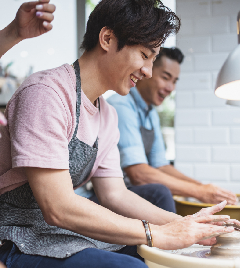Piles, or haemorrhoids, are areas in the anal canal where the tissue has become swollen. They are very common at any age.
Piles are round swellings on the inside of the anal canal - the short, muscular tube that connects your rectum (back passage) with your anus - in areas known as the anal cushions.
Many people with piles don't consult a doctor so it's difficult to know exactly how many people in Hong Kong get them.
Types of piles
Although piles develop from inside your anal canal, they can hang down out of your rectum. They are graded as follows.
- First degree piles are swellings on the inside lining of your anal canal. They may bleed but can't be seen from outside the anus.
- Second degree piles are larger and stick out (prolapse) from the anus when you have a bowel movement, but return on their own afterwards.
- Third degree piles are similar, but hang out from your anus and only return inside when pushed back in.
- Fourth degree piles permanently hang down from your anus and you can't push them back inside. They may become extremely swollen and painful if the blood in them clots.
- External piles are swellings that develop from below the anal cushions. They can be more painful than the other types of piles.
Other causes of lumps around the anus can include a sentinel pile, which is the painless skin tag that develops when a crack in the anus (an anal fissure) heals up.
Causes of piles
The exact cause of piles is not known. One theory is that piles are a result of a weakness of the tissue that connects the anal cushions to the muscle layers underneath. In combination with frequently straining while passing hard bowel movements, this can cause the anal cushions to slide out of their usual place and down the rectum.
You are more likely to develop piles:
- if you eat a low-fibre diet
- if you strain to empty your bowels (for example, if you have constipation)
- as you age because the support structures in your rectum weaken
- if you're pregnant
- if you're born with a weakness in your rectum or have a family history of piles
Symptoms of piles
Common symptoms of piles include:
- painless bleeding from your anus, which you may notice in the toilet bowl or when you use toilet paper, or from soiled underwear
- a lump on your anus
- a slimy discharge of mucus
- a feeling that your bowels have not emptied completely
- itchy skin around your anus
- swelling around your anus
- pain and discomfort after a bowel movement if you have external piles
These symptoms may be caused by problems other than piles. You should visit your doctor for advice.
Diagnosis of piles
Visit your doctor if you notice any signs of bleeding from your rectum.
Your doctor will ask about your symptoms and examine you. This may involve a rectal examination, where he or she will gently insert a gloved finger into your rectum. Your doctor may also ask you about your medical history.
Your doctor may use a proctoscope to look inside your rectum. A proctoscope is a narrow, tube-like telescopic camera. Air can be blown through the tube to open up the bowel so it can be seen more clearly. This test can help to rule out problems in your rectum.
Alternatively, your doctor may refer you for a flexible sigmoidoscopy or colonoscopy test that will need to be done in hospital. This allows your doctor to look inside your large bowel. These tests are sometimes done to check that your condition isn't caused by something more serious.
Treatment of piles
There are a number of treatments that can help relieve the symptoms of piles, but there isn't a cure.
Self-helpRegular warm baths may relieve irritation and help to keep the anal area clean. It is important not to strain your bowels during a bowel movement. If you have daily bowel movements that are solid but soft, you won't need to strain as faeces will pass easily and won't put pressure on the blood vessels in your anal area.
MedicinesThere are a range of medicines that can help relieve the symptoms of piles.
- If you're passing hard or infrequent faeces, you could try a fibre supplement such as ispaghula husk (eg Fybogel) or mild laxatives such as lactulose, which will soften your faeces. Don't use laxatives that stimulate the bowel, such as senna, unless your doctor advises you to.
- Soothing creams, ointments and suppositories may ease any pain and itchiness. There are many different products available. Some contain a local anaesthetic such as lidocaine.
- Products containing corticosteroids, such as Anugesic-HC and Proctosedyl, may reduce inflammation and pain.
Always read the patient information leaflet that comes with your medicine and if you have any questions, ask your doctor or pharmacist for advice.
If these self-help measures and medicines don't work, or you have a higher grade of piles, you may need to go into hospital for one of the following procedures.
Non-surgical treatmentsThese are treatments that you can have in hospital, but you won't need to stay overnight.
BandingThis is used mostly to treat second degree piles, but you can also have it with first degree piles if medicines haven't worked for you.
This procedure needs to be done using an endoscope. Your doctor will place a small elastic band just above the pile. This will cut off the blood supply to the pile, causing it to die and fall off after a few days. The area left behind will heal up naturally.
SclerotherapyIn sclerotherapy your piles will be injected with an oily solution, which makes them shrivel up. It's used for first or second degree piles.
Other treatments include:
- infrared coagulation or laser, where infrared light is used to seal the veins above the pile causing it to shrink
- cryosurgery, which destroys the pile by freezing it - the pile will later shrink and fall off
- bipolar diathermy and direct current electrotherapy, where an electrical current is used to burn the pile off
However, there is little scientific evidence to support the use of these treatments. More research is needed.
SurgeryThere are various surgical treatments for piles.
Conventional haemorrhoidectomyThis is the surgical removal of piles and is only used if you have severe piles and other treatments - such as banding and sclerotherapy - haven't worked.
Conventional haemorrhoidectomy is done under general anaesthetic. This means you will be asleep during the operation. Your surgeon will cut the pile away from the muscle underneath and tie off the blood vessels to prevent bleeding. The exposed wound area will then heal naturally. Your surgeon may use stitches to close the wound.
Stapled haemorrhoidopexyThis is an alternative surgical technique that uses a specially-designed circular stapler. The stapler is inserted into the rectum and used to remove a doughnut-shaped piece of tissue above the piles. This pulls the haemorrhoids back up the anal canal and also reduces the blood supply to the piles, which shrink as a result. Recently a review of the value of this operation showed that compared with conventional haemorrhoidopexy, stapled haemorrhoidopexy led to less pain afterwards, a shorter stay in hospital and a shorter recovery time. However, there was a greater risk of piles returning and hanging down from your anus.
Haemorrhoidal artery ligationIn this procedure the small arteries that supply blood to the piles are tied with sutures. This causes the piles to shrink. It is sometimes referred to as HALO (haemorrhoidal artery ligation operation).
Special considerationsPiles are common in pregnant women. However, surgery is rarely considered an appropriate treatment since piles should get better after giving birth.
If you are pregnant, it's important to modify your diet to include more fibre as this will help to soften your bowel movements. If this doesn't help, ask your doctor about mild creams and ointments.
Prevention of piles
You can reduce your risk of developing piles. If you have daily bowel movements that are solid but soft, and you don't need to strain, faeces will pass easily and won't put pressure on the blood vessels in your anal area.
To keep your bowel movements soft try to:
- eat plenty of fibre-rich foods such as fruit, vegetables and wholegrain cereals (for example, brown rice, wholemeal bread and wholemeal pasta)
- drink plenty of fluids
Disclaimer
This information was published by Bupa Group's Health Content Team and has been reviewed by appropriate medical or clinical professionals. To the best of their knowledge the information is current and based on reputable sources of medical evidence, however Bupa (Asia) Limited makes no representation or warranty as to the completeness or accuracy of the Content.
The information on this page, and any information on third party websites referred to on this page, is provided as a guide only. It should not be relied upon as a substitute for professional medical advice, nor is it intended to be used for medical diagnosis or treatment. Bupa (Asia) Limited is not liable for any loss or damage you suffer arising out of the use of, or reliance on, the information.
Third party websites are not owned or controlled by Bupa and any individual may be able to access and post messages on them. Bupa is not responsible for the content or availability of these third party websites. Last updated August 2017.









